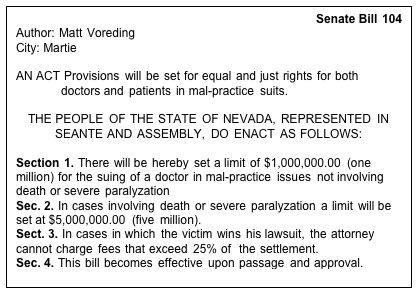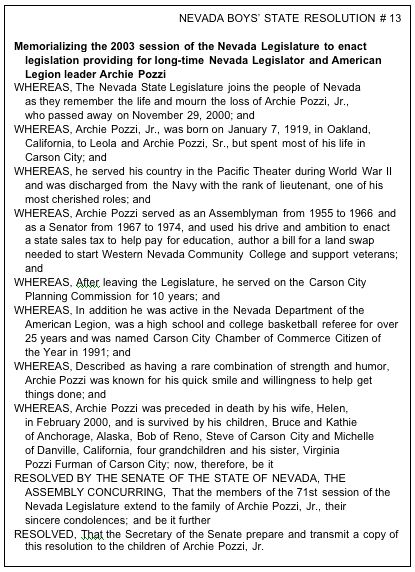How To Write and Submit Legislation
Learn the importance of legislation.
Overview
The NBS Legislature Online is your first resource for legislation drafting and online submission. Please submit at least one bill or resolution before the program begins. We strongly suggest that you submit a bill (and not a resolution). We will discuss the difference between bills and resolutions, and the particularly intricacies or a resolution at the program.
There is little doubt after a week at Nevada Boys State you will be able to write legislation, track legislation and form coalitions while promoting a legislative agenda. This site is designed to provide the tools and information to begin the process of writing a one resolution or bill and submitting it to the NBS Legislature Online system. (Once the legislation is submitted it is proofed by the staff, numbered and assigned to your committee.) If at any point you require additional assitance, please e-mail legislature@nevadaboysstate.org. Your delegate manual also includes as comprehensive section about drafting and submitting legislation.
The Boys State Legislature may take action through two types of legislation: a bill or a resolution. Ideas for legislation stem from daily life, businesses, lobbyists, and citizens. You may also wish to visit the Nevada State Legislature and explore the bills and resolutions that are being heard and have been heard by your state legislatures.
Writing a Bill
A bill creates a new law, amends or repeals existing law, appropriates money, prescribes fees, transfers functions from one state agency to another, provides penalties, or takes other action. A proposal intended to have the effect of statutory law must be enacted as a bill. Below is an example of a bill, there are additional examples in your delegate manual.

As you can see the bill is made of two central components (1) a summary and (2) a body. The summary includes a brief explanation, while the body is the text of the bill and divided into sections. If you intend to write a bill, you should now visit the submit page, where you will:
1) Title your bill (please note the title will change to the bill number once it has been review by the staff)
Ignore the view permission, edit permission and scheduling options if they are visible.
2) Write your name in the "Submitted By" box
3) Write a brief summary of your bill.
4) Write the text or body of your bill. (Note, you should use sections, in orther words "Section 1," "Sec. 2", etc.
5) Select the type of legislation your are submitting, either a bill or a resolution.
Leave the Amended, Anticipated Hearing and Status selections as they are.
Writing a Resolution
A resolution is not a proposed law, like a bill (or act). It is a formal expression of opinion or will of a legislative body. It is introduced, debated, and voted upon only by the members of that body. They typically fall into two categories: 1) An honorary resolution recognizing an individual or group for contributions they have made to the state or a community (Everyone votes in support of an honorary resolution to express one single voice.), and 2) A formal resolution calling for specific action to be taken by the legislative body. If both houses are in concurrence (or agreement), the resolution becomes a Joint Resolution. It is important to understand the characteristics of a resolution and some may wish to draft resolutions, however most citizens will be will be working to enact new laws or change existing laws and thus drafting bills. Please do not confuse the two forms of legislation, for each serves a unique purpose.
During the 2001 session of the Nevada Legislature Senate Concurrent Resolution 13 (SCR-13) was enacted as follows (please note the resolution was shortened for this context):

As you can see a resolution is made of two central components (1) a summary and (2) a body, like a bill. The summary includes a brief explanation, while the body is the text of the resolution. Unlike a bill, the body is divided into numberas "Wheras" clauses and one finale "be it resolved clause." If you intend to write a bill, you should now visit the submit page, where you will:
1) Title your resolution (please note the title will change to the bill number once it has been review by the staff). Ignore the view permission, edit permission and scheduling options if they are visible.
2) Write your name in the "Author" box.
3) Write a brief summary of your resolution.
4) Write the text or body of your resolution. (Make sure to include several "Whereas" sections and one final "Be it resolved section."
5) Select the type of legislation your are submitting, either a bill or a resolution.
Leave the Amended, Anticipated Hearing and Status selections as they are.



